-
Car Reviews
- Car News
-
Car Comparisons
Latest comparisons
- Chasing Deals
The new Nissan Juke packs in plenty of style and it drives well – but it lacks some important substance, especially in the mid-spec variants.
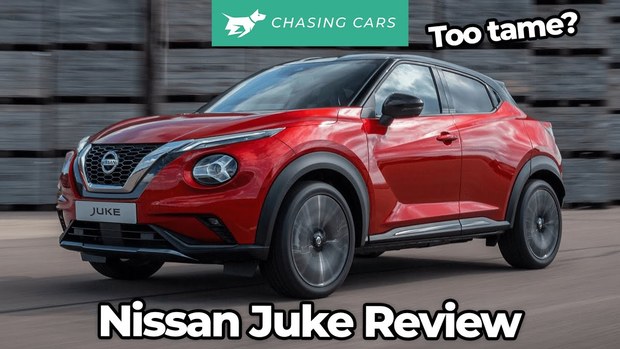
The Nissan Juke is a divisive vehicle, and in first-generation form, it was as much a sales success globally as it was a punchline. The second-generation Juke turns up the maturity but retains many of the jaunty cues that made the initial release so aesthetically memorable.
In Australia, it was arguably the original Toyota RAV4 that opened the public’s eyes to the wonders of the light SUV, but it was the circa-2010 Nissan Juke that refined the segment. Details like hidden door handles and unconventional surfacing first seen on the Juke are now must-haves in the class.
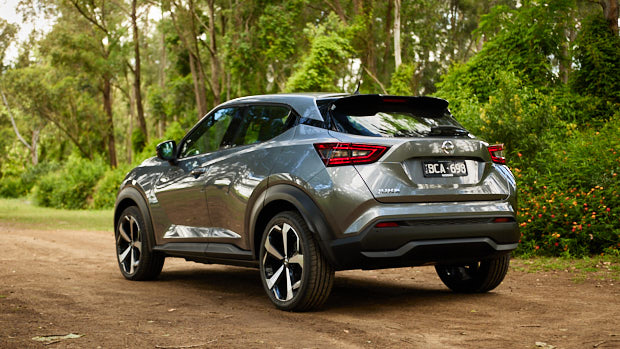
The exterior styling won’t appeal to Camry buyers, but the bulging beltline and narrow cabin lends the Juke an athletic stance. Nissan will tell you that the Juke takes inspiration from the GT-R and 370Z sports cars, specifically in the A-pillar and windscreen interface – it’s a stretch, but squint and the DNA is there.
As for specification, our $33,940 (before on-roads) ST-L is smack-bang in the middle of the range. Crucially, the ST-L is the most affordable Juke you can get with a leather-wrapped steering wheel. For 2021 a new ST-L+ variant has been added, which adds the Bose stereo to the ST-L, a nice touch for only $35,140 plus on-road costs.
Nissan has designed fun into the Juke’s exterior, but they’ve also engineered it into the driving experience which was a pleasant surprise. Under the bonnet is a turbocharged one-litre three-cylinder petrol engine with modest outputs of 84kW of power and 180Nm of torque.
Overtaking on country roads requires significant pre-planning, and any incline sees the throttle pedal head towards the carpet. That said, the engine is honest and charming in the way it delivers power.
A seven-speed dual-clutch automatic gearbox makes light work of shifts under load but it wasn’t without issue. The clutch slips too much before a sudden release, making for jerky manoeuvring. Volkswagen’s DSG transmission in the T-Cross is slicker.
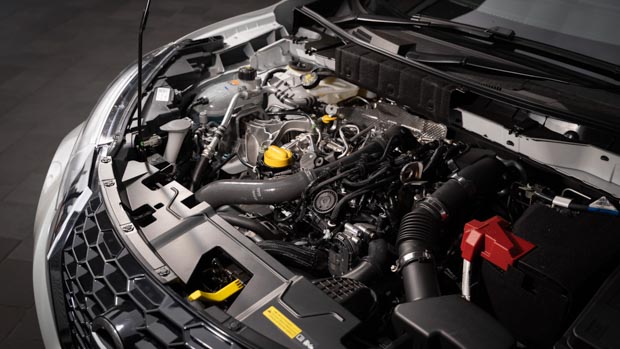
In normal mode the ‘box is programmed to shift to the highest gear imaginable which leaves the Juke flailing in turbo lag entering a roundabout. The transmission also misses out on a dedicated manual mode, which is a shame because the Juke steps up when the road gets tricky.
It would be unfair to take credit away from Nissan entirely, but the Juke drives with a decidedly French character. In fact, it feels rather like a tall Renault Clio, which is no surprise given the shared alliance CMF-B platform.
What this means in practice is that the Juke loves undulating and pockmarked roads, soaking up compressions and uneven surfaces with aplomb. Tightening, off-camber corners show reasonable outright grip and good poise. The Juke is up for some off-throttle antics, too, as the body pivots under the crook of the driver’s knee like small Peugeots of old.
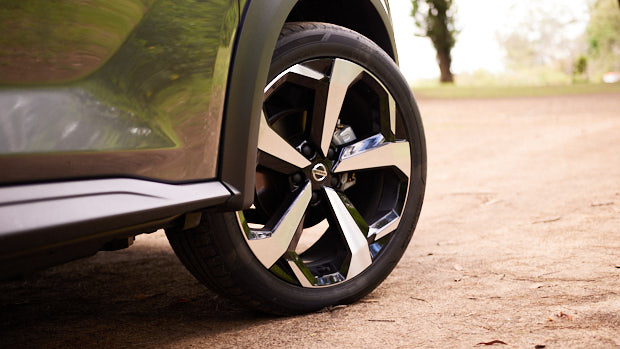
Ride quality is superb on the whole, but the ST-L’s 19-inch alloys contributed to an abrupt low-speed ride and trim rattles. NVH wasn’t well suppressed either, tyre roar made it into the cabin at quite a volume.
The Juke’s steering is light and easy, with the short overall length enough to make the Juke a cinch to manoeuvre. In its ST-L spec, our Juke was handily equipped with front and rear parking sensors and a 360-degree monitor.
Every Juke variant is equipped with a decent safety suite including auto headlights, rear parking sensors, AEB with pedestrian and cyclist detection, rear cross-traffic alert and an average lane-keep assist program. The ST+ adds front parking sensors to the base spec, but the Ti only really adds tyre pressure monitoring over this ST-L.
Take a close look at the Juke’s interior and the Gallic platform quirks continue. One dead giveaway being the bonnet release – it’s on the passenger side…
However the design is not so French; the ambient lighting surrounding the gear selector and angular styling mirrors that very Japanese exterior swagger. Material quality is a let-down though, with hard touch door plastics even on this upper-trim ST-L and generally flimsy assembly, though there is soft padding on the transmission tunnel.
From ST+ grades up DAB radio is standard, and this ST-L gets navigation with traffic updates, but you have to lay out for the ST-L+ for a decent stereo. Annoyingly, only models above this ST-L get a centre armrest and leather-appointed steering wheel.
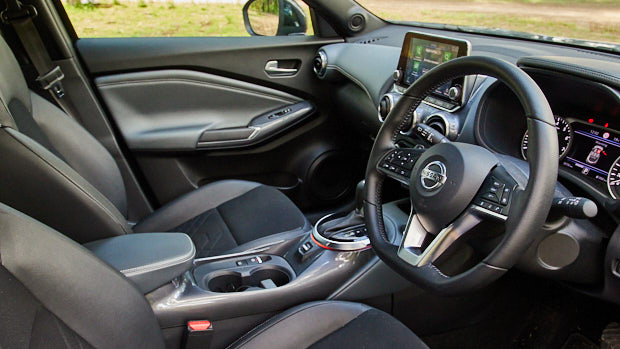
Apple CarPlay and Android Auto are standard and work via a wired USB cable, but we experienced multiple drop-outs and crashes of smartphone mirroring during our week in the Juke.
Despite the SUV tag, the Juke’s seating position is rather sporty with manually adjustable seats drop down to offer plenty of headroom. Nissan does seats extraordinarily well and the Juke is no exception; this ST-L gets leather accents on the bolsters and heating for both driver and passenger.
Front storage is adequate with two cupholders in the centre and door pockets large enough for a 700mL bottle. Keyless entry is standard but you still have to press a button on the handle to unlock the car.
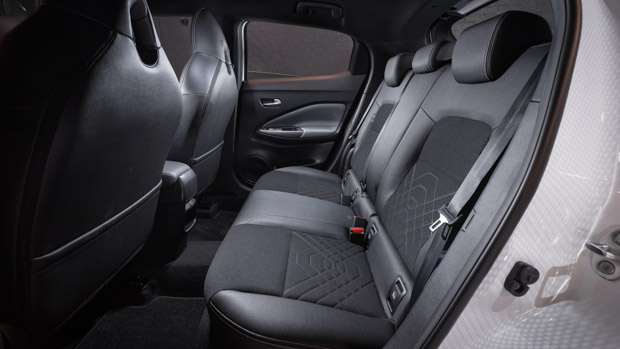
Second-row passengers are left rather high and dry in the Juke with no adjustable air vents or armrest, though there is a single USB charging port. Space is better than expected. At six-foot-two I could just sit behind my own driving position which is impressive and headroom was agreeable.
Like the front, though, the plastics are all hard and scratchy and the rising beltline cocoons, which could promote travel sickness for shorter occupacts. The actual bench is hugely comfortable, and there are two ISOFIX ports with flip up covers on the outboard seats.
Measuring 422L, the Juke’s boot is huge for the class, meaningfully besting the Mazda CX-3 (264L) and nearly taking out its bigger Qashqai sibling (430L). You don’t get much in the way of niceties, though, with but two shopping back hooks and a pronounced load-lip. Still, Nissan managed to fit a space saver spare under the carpet for some peace of mind.

During our tenure the Juke came near its 6.7L/100km claimed fuel consumption, mixing urban running with freeways and country roads resulted in a figure of 7.4L/100km. That won’t bother a hybrid Toyota C-HR but is otherwise reasonable. You will need to spend up on premium unleaded at the bowser, however.
Nissan backs the Juke with a five year, unlimited kilometre warranty which is adequate without bothering the seven year warranty offered on the Kia Stonic.
The Nissan Juke is also covered by five years free roadside assist for extra peace of mind.
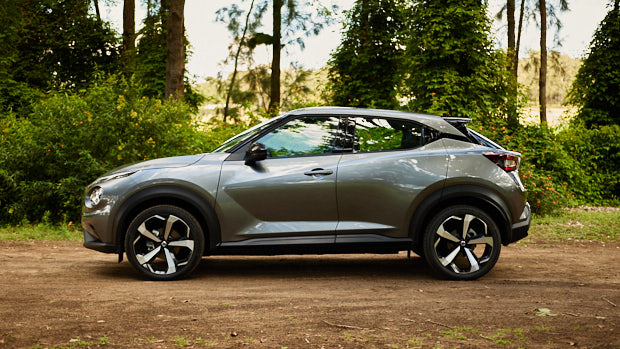
Servicing is recommended every 12 months or 20,000km and the first five services are set at $287 for the first service, $419 for the second, $477 for the third, $419 for the fourth, and $407 for the fifth, bringing the five-year cost to $2,009, which is average for the class.
Nissan recommends scheduled maintenance every 12 months or 20,000km – a rather long interval. Over a five year period it will cost $2,009, but Nissan offers six years of capped-price maintenance.
Within the fraternity of small, funky looking SUVs the Juke really is a strong performer both visually and on the road. It has matured notably since the first generation car, too.
That DCT gearbox won’t suit everyone and nor will the level of fit and finish inside the cabin – as cool as it looks, there will be some nasty rattles for owners to deal with down the track.
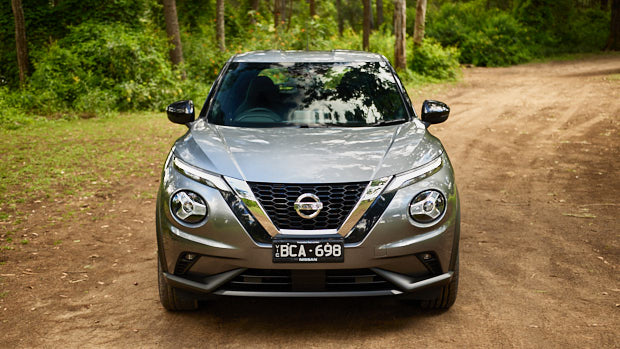
The specification level is lacking at the lower end, too, the plastic steering wheel makes it difficult to recommend the ST+ variant despite its otherwise good level of equipment.
There is plenty of good news, though. The packaging is really impressive for such a small vehicle, and the Juke is one of the best driving cars in its segment thanks to fluid, predictable dynamics, though a punchier engine option in the range would give the Juke (another Juke NISMO, perhaps?) even more kerb appeal.
Variant tested ST-L
Key specs (as tested)
About Chasing cars
Chasing Cars reviews are 100% independent.
Because we are powered by Budget Direct Insurance, we don’t receive advertising or sales revenue from car manufacturers.
We’re truly independent – giving you Australia’s best car reviews.
The estimate provided does not take into account your personal circumstances but is intended to give a general indication of the cost of insurance, in order to obtain a complete quote, please visit www.budgetdirect.com.au. Estimate includes 15%^ online discount.
^Conditions Apply
Budget Direct Insurance arranged by Auto & General Services Pty Ltd ACN 003 617 909(AGS) AFSL 241 411, for and on behalf of the insurer, Auto & General Insurance Company Limited(ABN 42 111 586 353, AFSL 285 571).Because we don’t know your financial needs, we can’t advise you if this insurance will suit you. You should consider your needs and the Product Disclosure Statement before making a decision to buy insurance. Terms and conditions apply.
Indicative quote based on assumptions including postcode , 40 year old male with no offences, licence suspensions or claims in the last 5 years, a NCD Rating 1 and no younger drivers listed. White car, driven up to 10,000kms a year, unfinanced, with no modifications, factory options and/or non-standard accessories, private use only and garaged at night.
^Online Discounts Terms & Conditions
1. Discounts apply to the premium paid for a new Budget Direct Gold Comprehensive Car Insurance, Third Party Property Only or Third Party Property, Fire & Theft Insurance policy initiated online on or after 29 March 2017. Discounts do not apply to optional Roadside Assistance.
2. Discounts do not apply to any renewal offer of insurance.
3. Discounts only apply to the insurance portion of the premium. Discounts are applied before government charges, taxes, levies and fees, including instalment processing fees (as applicable). The full extent of discounts may therefore be impacted.
4. We reserve the right to change the offer without notice.